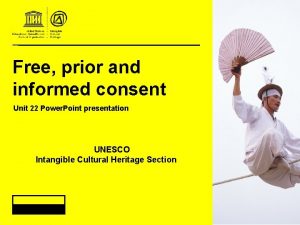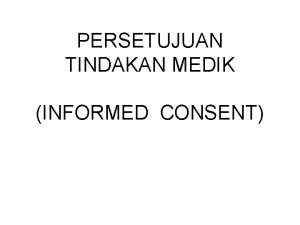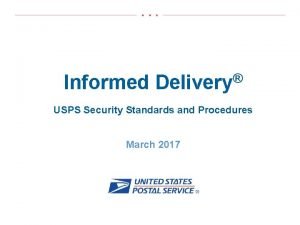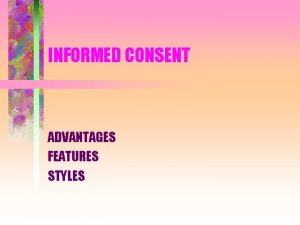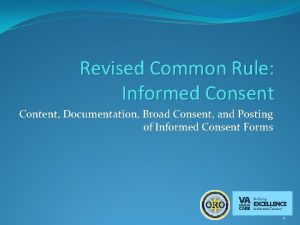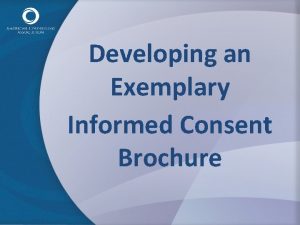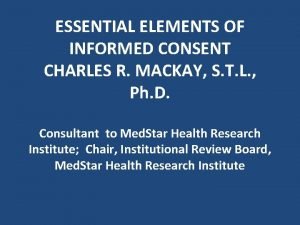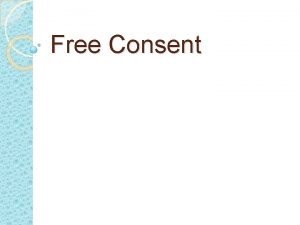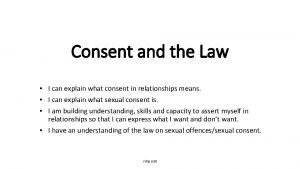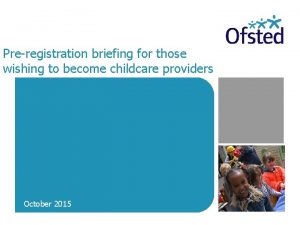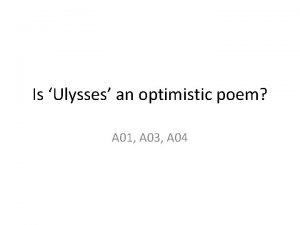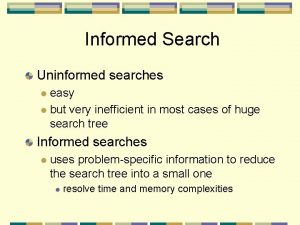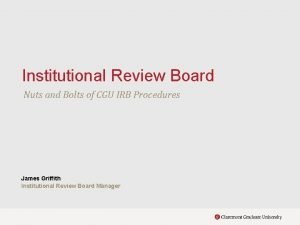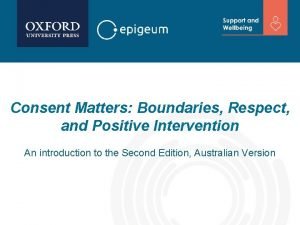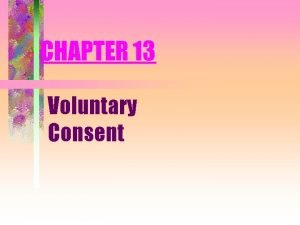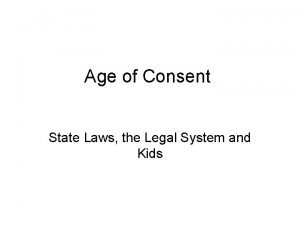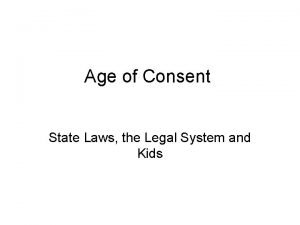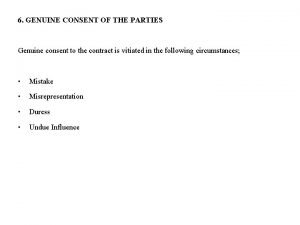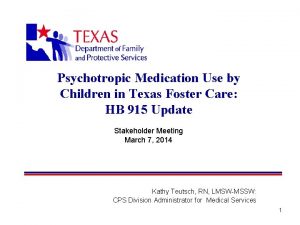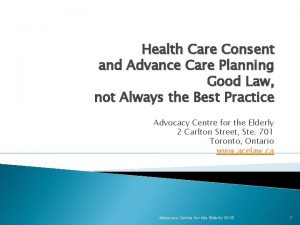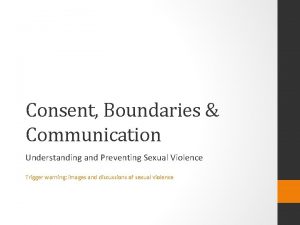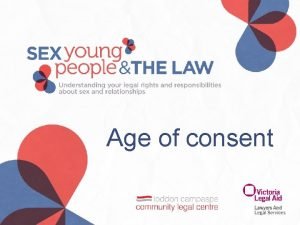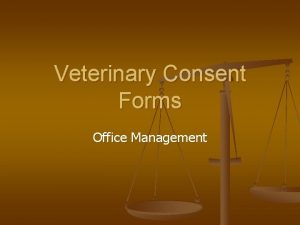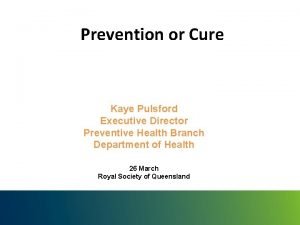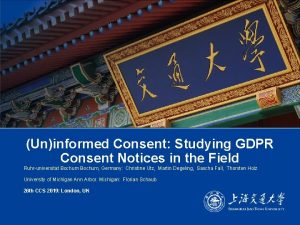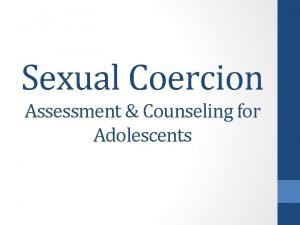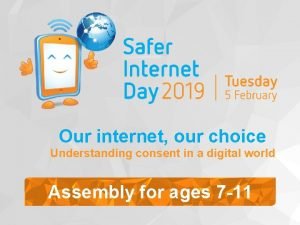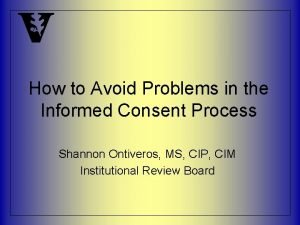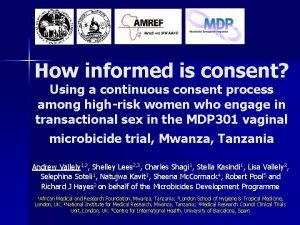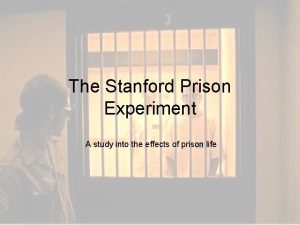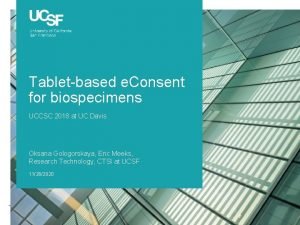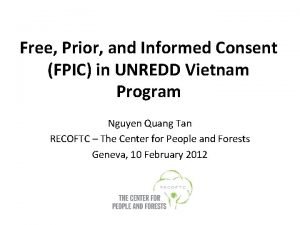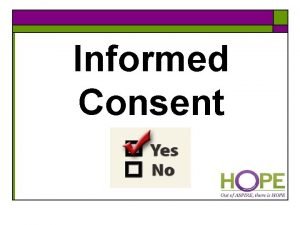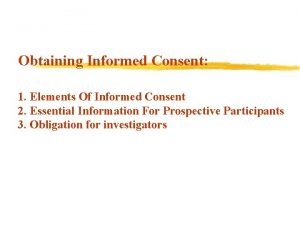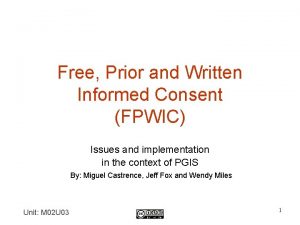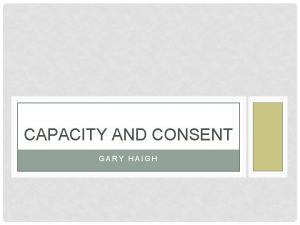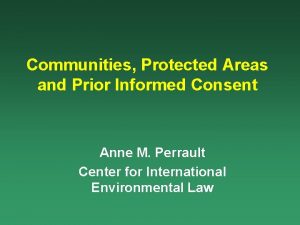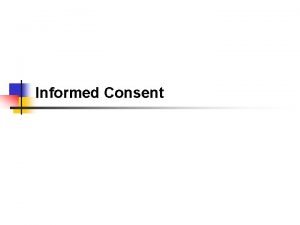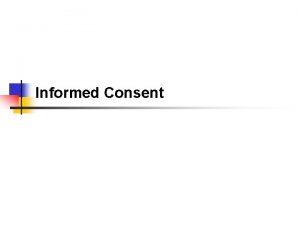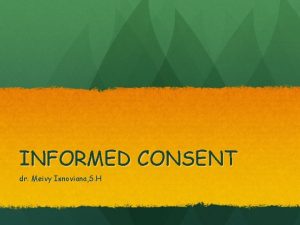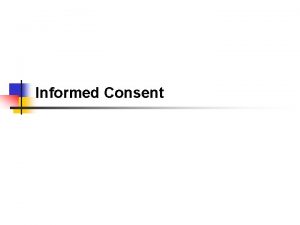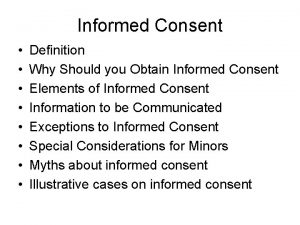Free Prior and Informed Consent FPIC in the

















































- Slides: 49

Free, Prior and Informed Consent (FPIC) in the FSC system Larry Joseph, Board of Directors, FSC and Janette Bulkan, Policy and Standards Committee, FSC Saskatoon, 4 December 2014

Structure of this presentation Following yesterday’s session on FPIC, we will now show you how FSC develops and applies FPIC. 1. What is the Forest Stewardship Council (LJ) 2. Two major categories of FSC certification (JB) 3. ‘Stakeholder engagement’ in certification of forest management (LJ) 4. FSC embeds FPIC in some FSC processes/documents (JB) 5. Draft requirements for FPIC in Controlled Wood processes (JB) 6. FSC Guidelines on FPIC (LJ) 7. Annex: FSC’s governance structure

1. What is the Forest Stewardship Council (FSC) • Quality Assurance Scheme • Voluntary, independent of government, thirdparties • Uses accredited conformity assessment bodies (CABs or CBs used synonymously for such bodies, e. g. Rainforest Alliance) for (audits) of conformance to FSC standards • FSC is not a direct seller of FSC-certified products but does provide some generalized support to small-scale certified producers.

2. Two major categories of FSC certification • Certification of the quality of forest management in defined areas, such as government-issued concessions or ‘forest tenures’; • Verification that 5 categories of high-risk timber do not enter market chain = FSC controlled wood. • In addition, FSC offers verification that there is a formal unbroken chain of custody of forest products – such as timber. This chain goes from the initial producer’s first point-of-sale onwards.

Scope of FSC certification • Globally: – 183 million hectares of FSC-certified forests – 1, 296 Forest Management/Chain of Custody certificates – 28, 470 Chain of Custody certificates • Canada: – 55 million hectares (one-third) of FSC-certified forests – 76 Forest Management certificates – 897 Chain of Custody certificates

3. Stakeholder engagement in certification of forest management

Haida Gwaii

Stakeholder engagement in FSC forest management certification processes • Applicants and holders of FSC forest management certificates have to identify ‘affected’ and ‘interested’ stakeholders in the course of FSC assessments for good forest management. • The identifications must be confirmed by accredited Conformity Assessment Bodies (e. g. Rainforest Alliance)

‘Affected stakeholders’ • Any person, group of persons or entity that is or is likely to be directly impacted by activities that take place in the area(s) where (s)he/they live or depend on for subsistence. • Examples: – – – – Indigenous Peoples Traditional Peoples, Forest dwellers, local communities Workers Local processors Local businesses Tenure and use rights holders, including landowners Representative NGOs

‘Interested stakeholders’ • Any person, group of persons or entity that has shown an interest, or is known to have an interest, in the activities of a specified place or area. • Examples: – Provincial and national governments – Governmental departments and agencies functioning in the region – Labour unions – Intermediary NGOs (national and/or international) – environmental, human rights

4. FSC embeds Free, Prior and Informed Consent (FPIC) in some FSC processes/documents • FSC has two basic documents – its statutes + by-laws and its globally-applicable principles and criteria (P&C) of good forest stewardship. • All other normative documents flow from these two.

Free and informed consent have been part of the P&C since FSC began in 1994.

• Application of free and informed consent by local communities is in Criterion 2. 2. • Wording from 1996 – • Local communities with legal or customary tenure or use rights shall maintain control, to the extent necessary to protect their rights or resources, over forest operations unless they delegate control with free and informed consent to other agencies.

FSC, the best certification system for First Nations • Application of free and informed consent by Indigenous Peoples is in Criterion 3. 1. • Wording from 1996 – • Indigenous Peoples shall control forest management on their lands and territories unless they delegate control with free and informed consent to other agencies.

• After the global endorsement of the UN Declaration of the Rights of Indigenous Peoples (UNDRIP 2007, endorsed by Canada in 2010), FSC included FPIC in the revision of its global Principles and Criteria, approved by the FSC membership in 2012. • FPIC is now explicitly mentioned in explanatory note 3 to Criterion 1. 2 and in several Criteria under Principle 3 – rights of Indigenous Peoples – • together with direct quotations from relevant articles of UNDRIP 2007 in the explanatory notes to Criterion 3. 4.

FSC’s Explanatory note on customary rights holders • Explanatory note 3 to Criterion 1. 2 says – ‘According to Criteria 3. 2 and 3. 3 and 4. 2, where the resource access rights of ‘The Organization’ overlap with pre-existing tenures, resource or land use the holders of the pre-existing legal or customary rights maintain control over their tenure and resource’ -- FSC -STD-01 -001 V 5 -0 D 5 -0 November 2011 (the revised P&C). • Clear statement of recognition of Native Title

FSC explanatory notes – not ‘normative’ • FSC explanatory notes are not part of the normative P&C and so are not binding, • but they should provide a good basis for arguments in favour of applicants or certificate holders (seeking or having been awarded logging concession by a State party over State/Crown Forests) having to obtain FPIC from holders of preexisting customary rights which are overlaid by Crown Forest categories.

5. Draft requirements for FPIC in Controlled Wood processes • Most big forest products enterprises in Canada do not have full FSC quality assurance forest management. • Instead, they draw supplies of controlled wood, which exclude the five named risk categories.

The five ‘unacceptable sources’ for FSC Controlled Wood categories are: 1. Illegally harvested wood; 2. Wood harvested in violation of traditional and human rights; 3. Wood from forests in which high conservation values are threatened by management activities; 4. Wood from forests being converted to plantations and non-forest use; and 5. Wood from forests in which genetically modified trees are planted.

• Assessment of risk by individual enterprises has been expensive and unreliable. It is being replaced by national risk assessment, organised in this country by FSC Canada. • Control measures to be followed in situations of identified (‘specified’) risk have been derived from FSC’s international generic indicators which are being finalised for Board approval.

FPIC required for ‘Controlled Wood’ • FPIC must be implemented forest management certification and for verification of Controlled Wood • Risk category 2 in Controlled Wood = ‘Wood harvested in violation of traditional and human rights’ • FPIC must be demonstrated in National Risk Assessments and by enterprises supplying Controlled Wood

Requirements for sourcing Controlled Wood 1. 14 Free, Prior and Informed Consent. Legislation covering ‘free, prior and informed consent’ in connection with forest management rights, and customary rights to the organization in charge of the harvesting operation. (4. 2) 1. 15 Indigenous Peoples’ rights. Legislation that regulates the rights of indigenous people as far as it’s related to forestry activities. Possible aspects to consider are land tenure, right to use certain forest related resources or practice traditional activities, which may involve forest lands. (4. 3)

Controlled Wood indicator Controlled Wood verifier 1. 14 Free, Prior and Informed Consent Stakeholder consultation provides evidence that legal requirements related to free, prior and informed consent was upheld regarding forest management rights. 1. 15 Indigenous Peoples/Traditional Peoples’ rights Stakeholder consultation provides evidences that Indigenous Peoples’/Traditional Peoples´ legally established rights are not being violated. Expert engagement to determine specific legal obligations regarding traditional and human rights, and to ensure that the legislation consulted is current (considers most recent amendments); and considers judicial decisions relevant to interpreting legal obligations.

Requirements for sourcing Controlled Wood 5. 6 The Organization shall recognize and uphold the legal and customary rights of Indigenous Peoples to maintain control over management activities within or related to the Supply Unit to the extent necessary to protect their rights, resources, and lands and territories. Delegation by Indigenous Peoples of control over management activities to third parties requires Free, Prior and Informed Consent. 5. 7 In the event of delegation of control over management activities, a binding agreement between The Organization and the Indigenous Peoples and/or Traditional Peoples shall be concluded through Free, Prior and Informed Consent.

Note the special relevance for Canada Controlled Wood indicator Controlled Wood verifier 5. 6 -5. 7 Stakeholder consultation confirms implementation of free, prior and informed consent (FIPC*) of Indigenous Peoples, Traditional Peoples, local communities with traditional rights in forestry operations in sourcing area.

Note: • Binding agreements may be, but are not limited to, written agreements. They must reflect cultural requirements and may also be based on oral and honor systems, to be applied in cases where written agreements are not favored by Indigenous Peoples and/or Traditional Peoples, either for practical reasons or on principle.

6. FSC Draft Guidelines on FPIC (2012) • FSC guidelines for the implementation of the right to free, prior and informed consent (FPIC), V 1 -0, 30 October 2012 – drafted by Leo van der Vlist (Netherlands Centre for Indigenous Peoples) and Wolfgang Richert (Wolf Consultancy) • Guidelines remain in draft but are scheduled to be under revision at this time

FSC General Assembly – September 2014 Side meeting held on draft FPIC Guideline • Decision announced: – In collaboration with FSC’s Permanent Indigenous Peoples Committee (PIPC) FSC Secretariat (Vanessa Linforth) and consultants to continue country-level field visits and consultations relating to FPIC, with a view to strengthening the Guidelines

PIPC at Oaxaca, Mexico PIPC: Feb’ 14

PIPC: Morogoro, Tanzania PIPC: June’ 14

2014 GA Side meeting on the draft FPIC Guideline: Larry presenting at Seville General Assembly

Right to FPIC in the FSC system • 1. Requires the identification of all affected Indigenous Peoples and Local Communities with legal or customary rights to land or resources in and around the forest area (‘management unit’)

Right to FPIC in the FSC system - 2 • 2. If these rights holders are willing to consider log harvesting by ‘The Organization’, the next step is an extensive and iterative process of engagement, in accordance with FPIC. • FPIC is not equal to ‘engagement’: IPs have the right to give, withhold or withdraw consent to those activities that would affect their rights.

Right to FPIC in the FSC system - 3 • 3. During this process, the affected communities must be given enough time and information to be able to give or withhold their consent, free of coercion or manipulation, at various stages of the process.

Right to FPIC in the FSC system - 4 • 4. This process entails, among others, culturally-appropriate communication, agreeing on inclusive decision models, capacity building, participatory mapping and participatory impact assessments and fair negotiations.

Right to FPIC in the FSC system - 5 • 5. This process may result in a negotiated consent agreement on the proposed forestry operation, or the affected communities may decide to withhold their approval indefinitely, or until certain conditions are met.

What’s the point? See The Vision Of PIPC

7. Annex: FSC’s governance structure

FSC’s governance structure • Three chamber governance structure: – Global North — Social, Economic and Environmental Chambers – Global South — Social, Economic and Environmental Chambers • National Offices – Annual membership fees of FSC members are paid to their National Offices – Canada has a fourth chamber: Aboriginal Chamber

FSC’s governance – International Centre in Bonn, Germany • Director General oversees the work of a number of Units: Legal, Policy and Standards, Quality Assurance, Smallholders, Social, Trademark, etc. • International Board of Directors has oversight of International Centre, sets policy and direction – Board comprised of 12 Members (equal weight to global North and South and to three chambers) • General Assembly held every three years, the first in 1996 and the latest in 2014

Evolution of FSC’s Standard • 1994 – Principles & Criteria with 9 Principles, • 1996 – Principle 10 on plantations • 1999 – Principle 9 re-worked for high conservation value forests (HCVFs) • From 1996 – FSC’s International Centre prepares numerous subsidiary and process standards, guidance, policies, discussion papers, clarifying advice notes, etc. Not always harmonized, not always well communicated to the wide range of stakeholders

Major revision of FSC P&C (2007 -2011, mainly 2009 -2011) • 4 major public and many interim drafts • 2 Social Chamber meetings • 1 Smallholder meeting, 1 meeting of National Offices • 2 technical workshops • Detailed written responses given to all the written comments on the public drafts 2 -4, in total over 2000 pages of comment and response, involving about ¼ of FSC membership • 12 thematic briefing papers and 46 FAQs , AND

Indigenous Peoples’ inputs into FSC Standard Revision Process • 2009: FSC convened 5 meetings of Indigenous Peoples (IP) representing Europe, North and South America, Africa and Asia • > 35 IP representatives from 27 countries participated

Current status of FSC Standard Revision • Revised Principles & Criteria approved by vote of the FSC membership in February 2012 • Development of International Global Indicators (IGIs) almost complete • 2 -year period for adaptation / transition of national and regional standards to the revised global Principles & Criteria and IGIs

Standard Revision Process – on-going • National and regional level Forest Stewardship Standards (FSS) should be entirely compatible with the global Principles & Criteria • can add locality- or situation-specific Criteria or Indicators but cannot change or omit any Principle or Criterion – Free, Prior and Informed Consent (FPIC) is embedded in all FSC documents

FSC forest management planning requirements can exceed national/provincial law • ‘For example, the planning required in Criterion 7. 2 may go beyond what is required by national or local law but is, nevertheless, a requirement for compliance with the FSC Principles and Criteria’ (Explanatory note 6 to the Scope section in the Preamble to the revised P&C)

Compliance with ‘Laws’ in FSC system • ‘Laws. ‘Complementing other initiatives’ in the context of laws means that the Principles and Criteria require compliance with national laws and ratified international conventions and agreements according to Principle 1, but may lay down provisions in Principles 2 to 10 that are more stringent than those in laws and regulations (Explanatory note 6 to the Scope section in the Preamble to the revised P&C)

FSC is separate from national law • Where the legal provisions of a country meet or exceed the requirements of the Principles and Criteria, then compliance with these legal provisions is considered sufficient for compliance with the Principles and Criteria, provided that compliance has been evaluated by conformity assessment bodies (Explanatory note 6 to the Scope section in the Preamble to the revised P&C).

Certificate holders have to meet FSC requirements • Where the legal provisions of a country do not meet or exceed the requirements of the Principles and Criteria, then following these legal provisions alone will not be considered sufficient for compliance (Explanatory note 6 to the Scope section in the Preamble to the revised P&C)
 22power dot com
22power dot com Dasar hukum informed consent
Dasar hukum informed consent Usps informed consent
Usps informed consent Ethical principles governing informed consent process
Ethical principles governing informed consent process Advantages of informed consent
Advantages of informed consent Broad informed consent
Broad informed consent Informed consent brochure
Informed consent brochure Essential elements of informed consent
Essential elements of informed consent Bala debi vs majumdar
Bala debi vs majumdar Consent and the law
Consent and the law Ey2 declaration and consent form
Ey2 declaration and consent form Helmholtz free energy and gibbs free energy
Helmholtz free energy and gibbs free energy The story of an hour summary
The story of an hour summary Happy isles ulysses
Happy isles ulysses What is informed search and uninformed search
What is informed search and uninformed search Uninformed search examples
Uninformed search examples Informed and uninformed search
Informed and uninformed search Wcu irb
Wcu irb Ic pvusd
Ic pvusd What is positive intervention consent
What is positive intervention consent Types of consent
Types of consent Voluntary consent meaning
Voluntary consent meaning Age of consent kentucky
Age of consent kentucky Age of consent per state
Age of consent per state Genuine consent
Genuine consent Dfps medical consent training
Dfps medical consent training Authentic consent
Authentic consent Health care consent act hierarchy
Health care consent act hierarchy Consent statistics
Consent statistics Age of consent la
Age of consent la Legal consent forms for veterinary practices
Legal consent forms for veterinary practices Minority consent dalam sosiologi adalah
Minority consent dalam sosiologi adalah The colonists paid lower taxes on molasses because of the
The colonists paid lower taxes on molasses because of the The consent elaine kaye
The consent elaine kaye Florida consent decree summary
Florida consent decree summary Emancipated minors definition
Emancipated minors definition Strategic context
Strategic context Impax epinephrine injection
Impax epinephrine injection The consent elaine kaye
The consent elaine kaye Uninformed consent
Uninformed consent What is sexual coersion
What is sexual coersion Consent
Consent Consent form for case report
Consent form for case report Consent
Consent Continuous consent
Continuous consent Consent gerund or infinitive
Consent gerund or infinitive Stanford prison experiment right to withdraw
Stanford prison experiment right to withdraw Auth portal pvusd
Auth portal pvusd Healtheconnections consent form
Healtheconnections consent form Ib psychology ia consent form
Ib psychology ia consent form
